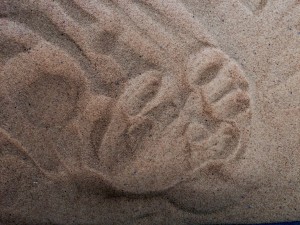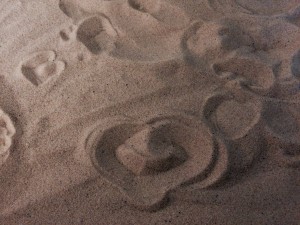SAND PLAY AND SYNCHRONICITY
“Dora Kalff, one of the first theorists and practitioners to use miniature figurines, referred to her unique approach as, “western meditation.” She was most influenced by Carl Jung, Margaret Lowenfeld, and a Tibetan monk refugee who lived in her home for seven years. Dora brought to the practice of sandplay therapy a combination of Neumann’s theory of personality development, Carl Jung’s concept of active imagination, and spirituality. Dora’s therapeutic directives for the process were very simple. She told patients to make a picture with the sand and figurines and then tell the story portrayed in the sandbox” (Scott in Sierra Tucson’s 2006 Progress Newsletter, Kalff, 1980).
I use sand tray experientials with my clients, as one of many art therapy and imagistic techniques in my repertoire. I have been collecting figurines for over twenty years. I have figurines collected from around the world, as well as small, antique figurines that belonged to my grandparents. I also have sacred semi-precious stones and gems. In my collection are families of figurines from five different races, and three generations for each family. I also have a large collection of animals and birds, fantasy and archetypes.
Jung first wrote about synchronicity. His concept, deeply embedded in spirituality, spoke to meaningful coincidences that cannot be explained by causal events.
I think of synchronicity as petite answers to my prayers. Most days I take a walking meditation and it is wondrous how often I find small items that comfort me on my spiritual journey. For example, recently, I found a heart shape (not exact) in the patterns of a found feather. I find heart shapes often.

How exciting then when this type of synchronicity happens for clients in our sessions. Recently, a client was processing (in a sand tray) a complicated and painful adult relationship. We discussed how the current relationship was possibly a replication of a childhood familial dynamic. The photo above at the top of the page, might not show it as clearly as it appeared in the session, but as we removed the figurines from the sand tray (about the current relationship), it looked as if there was a small child’s hand print in the sand. I looked at the bottom of each figurine, most of them round, and I cannot figure out how those patterns created what appeared to be a child’s hand print. The image of what appeared to be a child’s hand print felt as it is was a confirmation of the direction we were taking in therapy. In that same tray, the person portrayed an ideal relationship. In her mind, this relationship included warmth, caring, listening, shared interests and creativity.
Underneath that section of the tray (notice that the symbols were specific to the location of the topic in the tray), the image looked a bit like two hearts, one inside of the other with a pyramid type shape in the middle.
I cannot tell you that I have proof of the meaning of these symbols. Instead, I ask you to check it out for yourself and tell me what you think. Please let me know if these symbols are comforting to you, and whether or not you can entertain the possibility that maybe there are other realities beyond concrete reality and the jungle of urban life.


